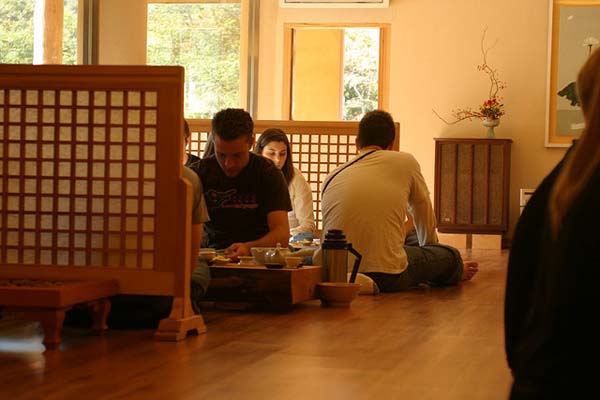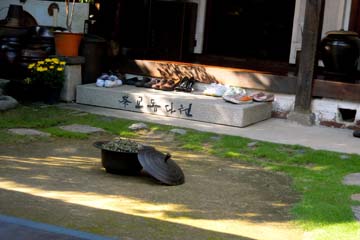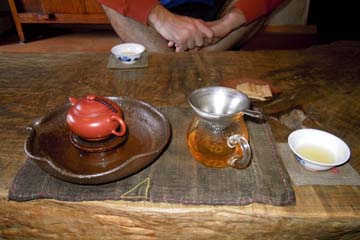Four Senses and a Teahouse

Photo: Drab Makyo / Other photos by author.
MY FIRST TRADITIONAL teahouse experience came half a block off the tourist trail, down a cobblestone path in Jeonju, South Korea. I was immediately hooked and have returned several times. On my last trip, I decided to close my eyes. I wanted to see what would happen.
The Smell
The sweet, warm musk of smoldering sandalwood. A deep breath stings, but only slightly. I detect other aromas like sniffing a fine wine. It lingers. Always. As if this were the natural state of the air. Brown sugar. Drought. Marijuana.

A humid whiff of steeping tea inhaled in sporadic wafts. The smell of calm and an elusive floral bouquet concealed in the plumes. Its there. It exists. But just on the tip of my nose before it evaporates into ambiance. Its an essence. Its a myth.
The residue of dryness. The composition of teas. Fruits. Flowers. Herbs. Parched particles carried by the sandalwood smoke and the tea steam, my hosts clean perfume and the odor of my socks to my nose. It reminds me of home.
That smell when I used to open the pantry.
The Sound
Music. Faint, but distinct. Shamefully, I think of Kung-Fu movies. The deep, resonating grumble of a gong directing a misty fog. The high-pitched wind from a bamboo pip! e slowly ushers it away revealing a sleepy remote monastery just awakening to the delicate vibrations of plucked strings.
And then the movement of air. Wind-chimes. Water ripples. Bodies shiver. I could be anywhere
But perhaps most important is what I cant hear. Not far from the main avenue, there are no honking taxis. No language that isnt my own. No overwhelming crowds. No crinkly maps, no hawkers, no camera clicks. The sound here is organic. Born from a breath, a beat, a breeze. Out there it invades, but in here its invited and the guest list is exclusive.
Despite all that, if I listen very closely, I can hearquiet.
The Touch
The smooth sanded surface of the maple tables. Its flaws. Islands of rough. Divots. A hole in the trunk. The winding edge feels like a coastline, beautiful in its imperfections.
The small ceramic serving bowl. (Surprisingly small.) Im a giant at tea-time. Though it still holds power over me. I warm my hands on it. (Curse the slowly waning heat. Nothing lasts.)

With my shoes off and my senses honed, I can actually feel my socks. Feel the breeze flowing through them and between my toes that rest rigidly on the hard floor.
I take a sip. Its almost too hotbut thats just right. Otherwise there wouldnt be that jolt of heat. A shot of whiskey. An electric shock. One more sip. One more feeling.
My sinuses clearing.
The Taste
The air has a flavor. Similar to the taste of pine needles or cinnamon, it is the savory embodiment of its smell. Deciduous.! Terrest rial. Crisp. I sense a certain astringency. The hollow flavor of dryness only quenched by what I supposedly came here for.
The tea.
It tastes oddly of steamed vegetables, though with an abridged flavor. Like licking the waxy surface of a pepper instead of biting it. Or bubble gum moments before the flavor expires. Subdued by dilution yet enhanced by heat, its at one moment unwelcome but the next intriguing in its unexpectedness.
I wouldnt order this cup again, but right nowits perfect. ![]()
Community Connection
Heading to South Korea? Make sure you brush up on the 10 Korean Customs to Know Before You Visit. And theres so much more than Seoul; find out what at South Korea, Beyond Seoul.
Comments